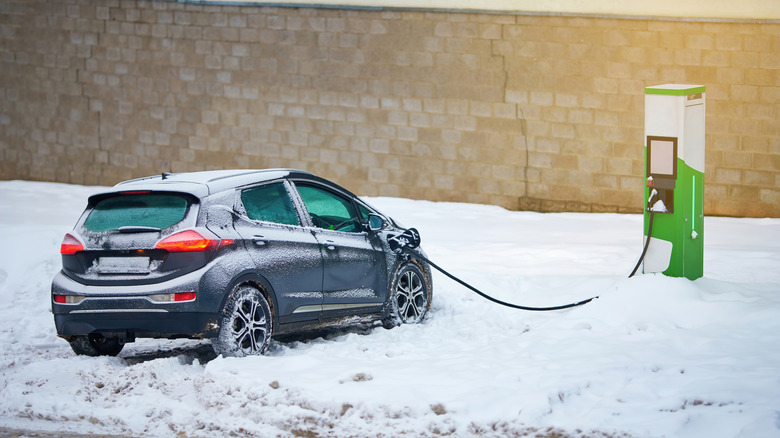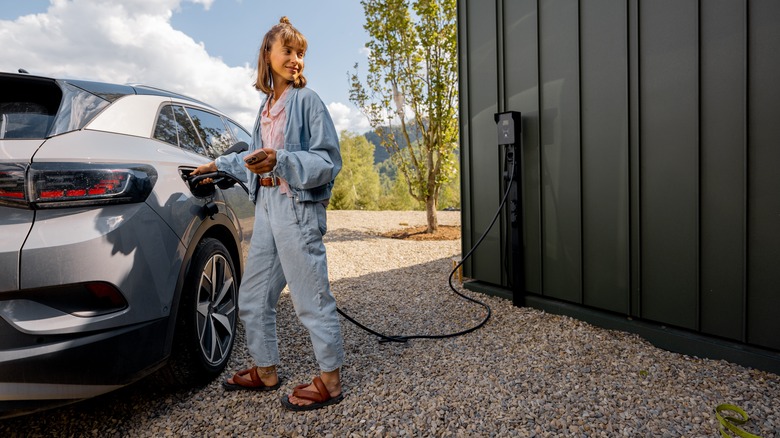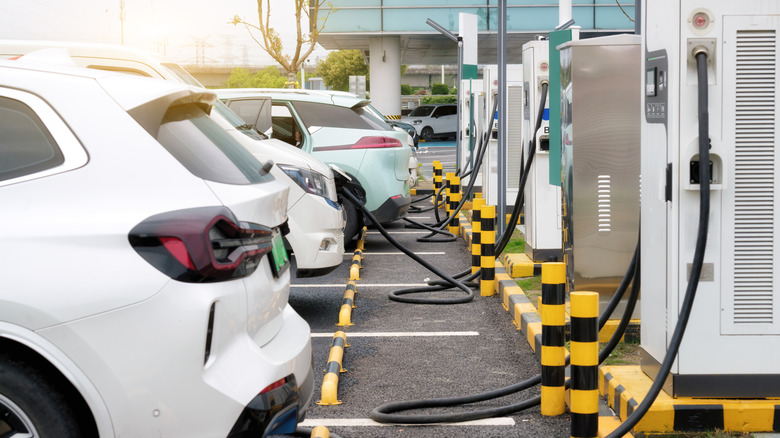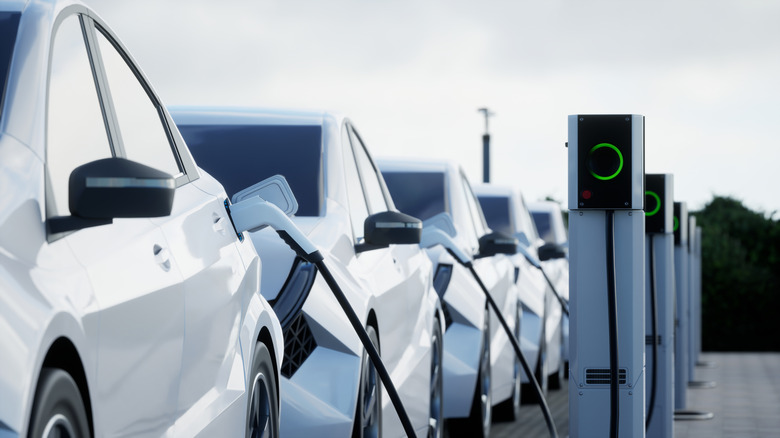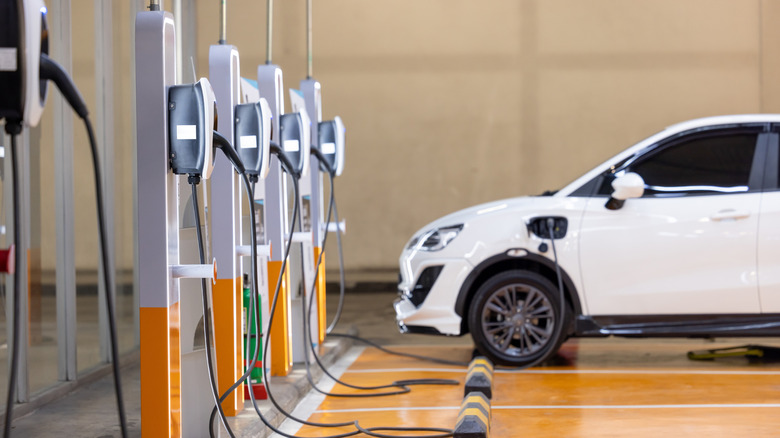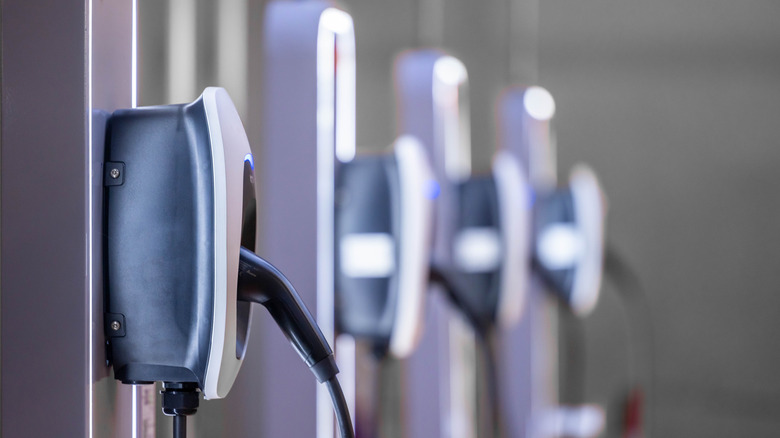5 US States With The Fewest Public EV Chargers
For prospective electric vehicle (EV) buyers and existing EV owners, range anxiety is a primary concern. At-home charging usually covers day-to-day driving, but it can be tough if you need to travel long distances and need to charge on the go. Any significant trip in an EV requires planning, especially if you live outside of the city where public chargers are harder to come by. Fortunately, things are getting better.
EV infrastructure has grown considerably in recent years. Today, there are about 75,000 publicly available EV charging stations throughout the United States, with more popping up all the time. Some stations only have a couple of chargers, while others can accommodate dozens or hundreds of vehicles. Taken altogether, there are more than 225,000 charging ports available. In recent years, the Department of Transportation (DOT) provided funding through the National Electric Vehicle Infrastructure (NEVI) program to state governments in order to improve EV charging infrastructure. Funding can cover up to 80% of installation, operation, maintenance, and more costs. It's worth noting that the NEVI program was halted in February of 2025, and the future of the program is unclear.
While things are improving for EV drivers nationwide, some states are more EV-friendly than others. If you're looking for somewhere to plug in while you're on the road, these are the five states where you'll have the hardest time, starting with the worst.
Alaska has the fewest EV charging stations of any state
Alaska is the largest state in the union by area (more than twice the square mileage of Texas, the second largest state) and it has the fewest public EV charging stations. There are just 65 stations with 155 total ports in the entire state. Of the country's more than 76,000 charging stations, Alaska has only 0.08%. Of course, there are some good reasons for that.
Despite Alaska's incredible size, the population of the entire state is only about three-quarters of a million people. In addition, the environment isn't necessarily friendly to EVs. Extreme temperatures may impact battery performance, making some residents of The Last Frontier resistant to making the electric leap. That's on top of the usual range anxiety, made worse by Alaska's wide-open spaces.
Alaska lacks any fast charging stations outside of Juneau, the state's capital. While public infrastructure needs improvement, the Alaska Electric Light and Power Co. offers an off-peak rate for charging at home between 10:00 p.m. and 5:00 a.m. You can even rent charging equipment to use at home, which you're probably going to need, considering the low number of public charging stations.
North Dakota is last in EV market share
EV adoption is happening more slowly in North Dakota than anywhere else in the country. In 2024, EVs represented about 10% of new car sales nationwide, but less than 2% of sales in North Dakota. The state ranks last in EV market share, with only about 2,300 EVs regularly driving on North Dakota roads. Surprisingly, the low number of EVs in the state has a surprising side effect. While there are only 100 public charging stations (with a total of 248 ports) in all of North Dakota, the state ranks second in charger-to-EV ratio, with approximately one charger for every 10 EVs.
North Dakota received $25.9 million as part of the NEVI program before it was halted, in addition to $1.2 million from the Advanced Transportation and Congestion Management Technologies Deployment (ATCMTD) Program. The state's goal is to place fast chargers within a mile of exits along the freeway and no more than 50 miles apart. These level three stations are capable of delivering about 100 miles of range after about 30 minutes plugged in. It's not as fast as filling up with gas, but that's the sort of infrastructure needed to make EVs suitable for long-distance cross-country travel.
Wyoming, EV infrastructure is lacking in the Cowboy State
Despite a smaller population than Alaska, Wyoming has 106 chargers (nearly twice as many) with 294 charging ports. The Cowboy State is second lowest in the nation in EV adoption, beating only North Dakota. There are a little more than 1,000 EVs registered in all of Wyoming. The low numbers may be driven by a combination of the state's wide open spaces, cold winters, and a culture that might be more opposed to EVs than other places.
While there aren't a ton of chargers in Wyoming, there are a few in some unexpected places. You can find a couple of chargers in the middle of the 5,000-acre Red Canyon Ranch, part of some rugged terrain where EV testing is taking place. There are more chargers popping up in more accessible places. In 2024, Wyoming received $5.5 million in federal funding to improve charging infrastructure in Jackson.
While the population of EV drivers in Wyoming is low, improved charging infrastructure would also benefit the millions of tourists who visit the Yellowstone and Grand Teton National Parks, not to mention the rest of what the Cowboy State has to offer.
South Dakota is in an EV desert
South Dakota has just 111 EV charging stations with 300 ports, serving a population of about 925,000 people. Like other states, South Dakota has an ongoing plan to improve EV charging infrastructure within its borders and connect to a larger nationwide network, though those plans are in flux following the suspension of the federal NEVI program.
The state created the South Dakota Electric Vehicle Fast Charging Plan as its framework for completing future EV infrastructure improvements. Still, there's plenty of work to do as current charging stations are few and far between. South Dakota rounds out the low-EV trifecta, alongside North Dakota and Wyoming, but the lack of EV chargers is only part of the problem. South Dakota also doesn't offer any tax incentives for purchasing or driving an EV. Moreover, EV owners pay an additional $50 at registration time.
The existing charging infrastructure in South Dakota, sparse as it is, is largely Level 1 and Level 2 chargers. Improvements are focused on adding Level 3 fast chargers close to freeways. While EV adoption in South Dakota may be slow, adoption across the rest of the country is happening much faster. Improving EV infrastructure in South Dakota contributes to a more robust nationwide network while making life easier for South Dakota residents.
Montana's EV infrastructure grows at a glacial pace
Montana's driving culture is dominated by pickup trucks. Approximately 35% of all vehicles registered in Montana are trucks, and EV adoption is growing more slowly than the rest of the country. The Montana state government was granted roughly $43 million from the NEVI program and is looking to continue building out EV infrastructure, particularly in high population areas like Missoula. The city itself has also added EVs and hybrid vehicles to its own fleet of vehicles. The only state on this list with a population over one million people (barely), Montana has just 149 public EV chargers with 459 charging ports.
While chargers are limited in Montana, you can find them at popular tourist destinations like Glacier National Park, and are working to add them in population centers where EVs are more likely to be, like at Montana State University. Still, other parts of the state remain underserved. You can find a smattering of chargers in places like Missoula and Billings, but they're harder to find the farther you get off the beaten path.
Why EV infrastructure matters
At present, EV charging infrastructure is concentrated in and around high-population city centers. The state with the highest number of chargers is California, followed by places like Texas, New York, and Florida. Chargers are less dense in other places which can pose a challenge no matter where you live. While it makes a certain amount of sense to put the chargers where the people are, there are reasons to expand infrastructure into less populated places.
If you want birds, you build a birdhouse. If you want more EV drivers, you need to build more chargers. People with greater access to public chargers tend to have more favorable views toward EVs, which impacts adoption. With that in mind, governments have taken a sort of "if you build it, they will come" philosophy. The idea is that by building improved EV infrastructure, and thereby making EV driving more accessible and convenient, people will be more likely to make the switch.
Additionally, improved EV infrastructure benefits everyone. EV owners might overwhelmingly live in or near cities, but they don't always stay there. More chargers in less populated areas help EV owners who are just passing through and local drivers.

